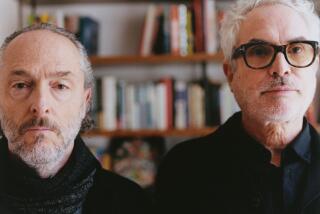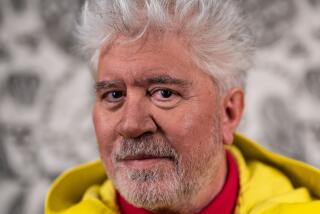A Second Look: Alejandro Jodorowsky’s ‘Santa Sangre’
Alejandro Jodorowsky has made only half a dozen features since the 1960s (two of which he has apparently disowned), but he is a towering figure in the annals of cult cinema, the man behind the first — and still the ultimate — counterculture midnight movie. Jodorowsky’s cosmic western “El Topo,” which he wrote, directed, scored and acted in, played for months in 1971 to downtown Manhattan crowds that gathered ritualistically for a kind of stoned midnight communion.
The filmmaker has contended that “head” movies are more than movies to take drugs to — ideally, they supplant the need for psychoactives. “When one creates a psychedelic film,” Jodorowsky once said, “he need not create a film that shows the visions of a person who has taken a pill; rather, he needs to manufacture the pill.”
The 1989 horror melodrama “Santa Sangre,” which is being issued in a two-disc edition in regular-definition and Blu-ray formats this week, is a straightforward, even mature effort by Jodorowsky standards — to the extent that those adjectives can be applied to a film about a serial killer under the malevolent spell of his armless mother, with whom he performs in a creepy cabaret act.
“Santa Sangre,” which pushes the Oedipal themes of “Psycho” out into the open (and onto the vibrant, crowded streets of Mexico City), is less acid-baked than “El Topo” and Jodorowsky’s other ‘70s trip, “The Holy Mountain” — and certainly less scandalizing than his violent 1967 debut, “Fando y Lis,” which caused a riot at its Acapulco premiere. But it’s quintessential Jodorowsky all the same: a vision dredged from the unconscious and designed to act on the nervous system.
This was the filmmaker’s comeback after nearly a decade away from the cinema, during which he developed a therapeutic method called psychomagic, rooted both in mysticism and psychoanalysis. You could think of it as the guiding philosophy behind “Santa Sangre.”
As in other Jodorowsky films, the protagonist is a Christ figure: a fragile soul named Fenix (the director’s son Axel Jodorowsky), first seen naked and perched on a tree stump in a mental institution. The movie flashes back to fill in the traumatic childhood of the young Fenix (another junior Jodorowsky, Adan): His American father was a circus knife thrower, his Mexican mother a trapeze artist. A lovers’ spat over the tattooed lady left his father dead and his mother without her arms. The adult Fenix remains devoted to his mother — in fact, his own arms, complete with red-painted nails, serve as her phantom limbs, obeying her commands both on- and off-screen. (The split between mind and body echoes the premise of Jodorowsky’s first short, now lost, called “The Severed Heads,” about a woman who cuts off and transposes the heads of two men.)
“Santa Sangre” is the Jodorowsky film that most fully draws on his nomadic, eclectic background. Born in Chile, he studied theater and was a puppeteer and circus clown before moving to Paris, where he performed mime with Marcel Marceau and fell in with the surrealist crowd. In 1960, he moved to Mexico, where he wrote a comic strip and mounted radical productions inspired by Antonin Artaud’s theater of cruelty.
“Psycho” is hardly the only cinematic influence on “Santa Sangre.” The circus grotesquerie suggests Fellini, though Tod Browning’s big-top movies “Freaks” and “The Unknown” are perhaps even more relevant. James Whale’s “The Invisible Man” is glimpsed on the television at one point. Also apparent is the lurid imprint of the film’s producer and co-writer Claudio Argento, brother of schlock-horror maestro Dario.
But for all its sundry inspirations, “Santa Sangre” never seems derivative. Jodorowsky’s anything-goes alchemy has a cumulative power, as does the documentary energy of his location photography. It’s a movie bursting with life — interrupted frequently by processions and pageants, shot in actual slums and red-light districts.
The specter of unmade movies hovers over Jodorowsky’s filmography. (He has been more successful in his parallel career as a cartoonist.) His most famous abortive project was an adaptation of Frank Herbert’s “Dune” that was to have starred Orson Welles and Gloria Swanson. David Lynch, a fellow surrealist and the filmmaker who ended up making “Dune,” came on board as a producer on a recent Jodorowsky project called “King Shot,” with Asia Argento and Marilyn Manson, which has since stalled. Supposedly still in development: an “El Topo” sequel titled “Abel Cain.”
Jodorowsky is nearly 82, and it has been more than two decades since he made a movie. But skeptics might want to check out the making-of documentary included on the “Santa Sangre” bonus disc, in which Jodorowsky recalls the reaction when that film was announced at Cannes. One journalist wondered if the long out-of-work Jordorowsky was rusty. His response: “A rusty knife is twice as deadly.”
More to Read
The biggest entertainment stories
Get our big stories about Hollywood, film, television, music, arts, culture and more right in your inbox as soon as they publish.
You may occasionally receive promotional content from the Los Angeles Times.










